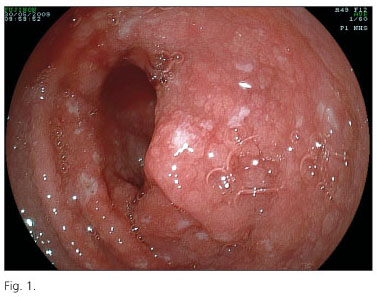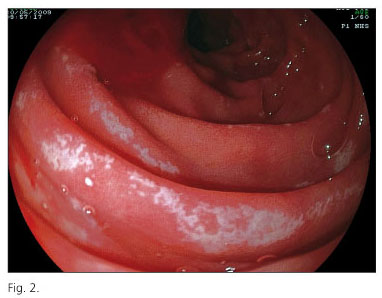Mi SciELO
Servicios Personalizados
Revista
Articulo
Indicadores
-
 Citado por SciELO
Citado por SciELO -
 Accesos
Accesos
Links relacionados
-
 Citado por Google
Citado por Google -
 Similares en
SciELO
Similares en
SciELO -
 Similares en Google
Similares en Google
Compartir
Revista Española de Enfermedades Digestivas
versión impresa ISSN 1130-0108
Rev. esp. enferm. dig. vol.102 no.7 Madrid jul. 2010
PICTURES IN DIGESTIVE PATHOLOGY
Duodenal erosions: an uncommon endoscopic marker of celiac disease
Erosiones duodenales: un hallazgo endoscópico infrecuente en la enfermedad celiaca
J. Molina-Infante, G. Vinagre-Rodríguez, E. Martín-Noguerol, J. M. González-Santiago, M. Hernández-Alonso, B. Pérez-Gallardo and M. Fernández-Bermejo
Unit of Gastroenterology. Hospital San Pedro de Alcántara. Cáceres, Spain
Introduction
Ulcers, erosions or strictures in celiac disease (CD), typically located in yeyunum and ileum, alert on complicated CD. The presence of these endoscopic abnormalities, both in duodenum and for non advanced cases of CD, are a rarity (1-3).
Case report
A 43 year-old woman, with long standing rheumatoid arthritis treated with metotrexate, presented due to diarrhea/mucorrea without rectal bleeding associated to marked weight loss of 4 months duration. Physical examination was normal. Laboratory work-up revealed iron deficiency anemia (haemoglobin 9,2 g/dL, ferritin 2 ng/mL) with serum tumor markers in normal range. Colonoscopy with ileal and colonic samples biopsy specimens did not disclose inflammation. Upper GI endoscopy showed nodular mucosa with patchy erosions in duodenal bulb (Fig. 1), whereas second and third part of the duodenum had erosions and slightly scalloped folds (Fig. 2). The patient denied surreptitious intake of aspirin or non-steroidal anti-inflammatory drugs (NSAIDs) and Helicobacter pylori infection was ruled out by gastric biopsies. Stool cultures for parasites, viruses and bacteria were negative, whilst normal gastrin level and constrast-enhanced abdominal ruled out Zollinger-Ellison syndrome. Histological examination of duodenal biopsy samples showed severe villous atrophy and numerous intraepithelial lymphocites, consistent with gluten sensitive enteropathy Marsh type 3b. Antibodies were also compatible with celiac disease (Ig A anti-tissue transglutaminase 112 UI, normal range < 7). The patient achieved clinical, endoscopic and histopathologic remission after 6 months of gluten free diet.
Discussion
Ulcers, erosions or strictures involving small bowel occur usually in advanced cases of CD, often in medium-distal segments and related to refractory disease or lymphoma-associated enteropathy. Despite being the site of greatest inflammation, the postbulbar involvement of the duodenum in non complicated CD has been reported to date up to 15 patients (1-3). The etiology of these lesions is unknown and they are believed to be promoted by underlying mucosal inflammation. Awareness on these atypical endoscopic features of CD is warranted, especially if other more frequent causes, such as H. pylori infection, NSAIDs or Zollinger Ellison syndrome, have been already precluded.
References
1. Dickey W, Hughes D. Erosions in the second part of the duodenum in patients with villous atrophy. Gastrointest Endosc 2004; 59: 116-8. [ Links ]
2. Schweiger GD, Murray JA. Postbulbar duodenal ulceration and stenosis associated with celiac disease. Abdom Imaging 1998; 23: 347-9. [ Links ]
3. Castiella A, Aramberri I, Fernández J, Carrera C, Legasa L, Ruiz I, et al. Celiac disease presented as duodenal ulcer and stenosis. Rev Esp Enferm Dig 2007; 99: 736-7. [ Links ]











 texto en
texto en 




